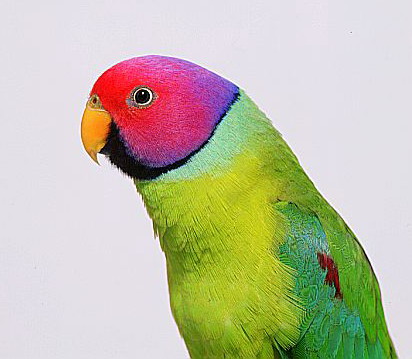
Plum-headed parakeet(Psittacula cyanocephala)
Phylum —chordata
Class — aves
Order — psittaciformes
Family —psittaculidae
Genus – psittacula
Appearance
The Plum-headed parakeet is a mainly green parrot, 33 cm long with a tail up to 22 cm. The male has a red head which shades to purple-blue on the back of the crown, nape and cheeks while the female has blueish-gray head. There is a narrow black neck collar with verdigris below on the nape and a black chin stripe that extends from the lower mandible. There is a red shoulder patch and the rump and tail are bluish-green, the latter tipped white. The upper mandible is orangish-yellow, and the lower mandible is dark. The female has a dull bluish grey head and lacks the black and verdigris collar which is replaced by yellow. The upper-mandible is corn-yellow and there is no black chin stripe or red shoulder patch. Immature birds have a green head and both mandibles are yellowish. The dark head is acquired after a year.
Habitat
It is endemic to the Indian Subcontinent.
Behavior
The Plum-headed parakeet is a gregarious and noisy species with range of raucous calls. The flight is swift and the bird often twists and turns rapidly. It makes local movements, driven mainly by the availability of the fruit and blossoms which make up its diet.
Diet
Plum-headed parakeets generally eat more fruit than other parakeets. However, their diet still includes large amounts of seeds in addition to fruit and nectar.
Reproduction
These parakeets have a breeding season from December to April throughout their range. In Sri Lanka they may have an additional season in July and August. Nests are made in holes in tree trunks and branches, with several pairs nesting together as a colony in small groups of trees. The four to five eggs hatch after 24 days’ incubation. Once hatched the chicks remain in the nest for around six weeks.
In captivity
A Plum-headed parakeet can live up to 30 years.
Because it has such a long tail, a Plum-headed parakeet is best suited to a relatively large cage. A cage with a 24-inch-by-36-inch footprint and 36 inches in height is a minimum requirement. Bar spacing should be no more than 1/2 inch. Include a different play gym containing toys within the cage, and another play gym separate from the cage for exercise periods. If you are keeping a pair of birds, provide them with a larger aviary enclosure. In an aviary setting, the Plum-headed is one of the few parrots that will happily coexist with non-competing birds, such as Finches.
Like any parrot, the Plum-headed parakeet needs some time each day outside the cage, but unlike other, more demanding parrots, the Plum-headed is not a cuddler that needs constant petting and hands-on play. Instead, it will likely be content to merely sit on your shoulder and "talk" with you. Without this level of daily interaction, though, the bird may withdraw and even become somewhat wild again.
In captivity, these birds must have an exercise and play area. These birds should be allowed a minimum of 3 to 4 hours outside the cage each day, in a safe, bird-proofed play area. Always supervise this free period to prevent accidents and injuries. This exercise and interaction time is critical for keeping a Plum-headed parakeet healthy and well socialized.
Like other parrots, Plum-headed parakeets do best in captivity when they eat a diet consisting of high-quality seed and pellet mix, supplemented daily with fresh, bird-safe fruits and vegetables. A bird will eat up to 1 tablespoon of food per day.
These birds enjoy variety in their diets, so experiment with foods like sprouts, leafy greens, berries, and even peppers. Birds cannot pick up on "spicy hot" flavors as humans do, so many of them enjoy picking apart spicy peppers to get at the seeds inside.
 Russian
Russian
 English
English























